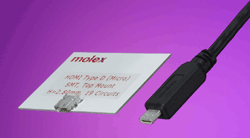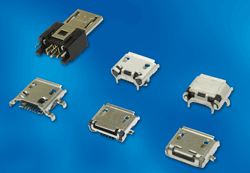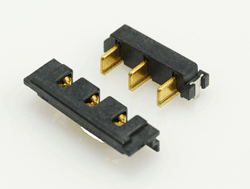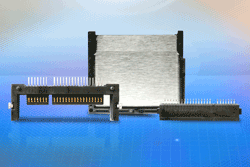Faster data rates, smaller mobile devices drive connector advances
BY GINA ROOS, Electronic Products
Digital convergence in the mobile communications market is challenging connector makers to new levels of innovation, revolving around smaller package sizes, higher density, and tighter pitch. These connectors also need to handle faster data rates as these mobile devices deliver higher functionality including high-definition (HD) video. Add environmental compliance issues and rising raw materials costs, and you've got a recipe for significant change in the world of interconnects.
One big surprise for connector makers as well as big OEMs this year is Apple's adoption of micro-SIM. The standard had been set by the European Telecommunications Standards Institute (ETSI) many years ago, but never was adopted by the industry until Apple decided to design it into its iPad and iPhone4, said Egbert Stellinga, global product manager for interconnection products for mobile devices at Tyco Electronics (Harrisburg, Pa.) As you would guess, the micro-SIM is smaller than the traditional SIM card.
Most connector makers agree that the killer app for 2010 is the smart phone. IDC, based in Framingham, MA, recently raised its forecast for smart phones by 10% due to greater than expected demand and a host of new devices, said Stellinga. The market research firm now expects 270 million smart phones to ship in 2010, up almost 55.4% compared to last year, driving up the overall mobile phone market growth to 14.1% in 2010, up 1.5% from the previous forecast, he added.
“In the old days a mobile device would be used just for speech. Now these devices are doing a lot of complex tasks and we're not happy when they aren't doing these things simultaneously,” said Bart van Ettinger, vice president of mobile devices at Molex (Lisle, IL)
This has put connector makers under a lot of pressure to develop smaller connectors that also can handle higher data rates. Multitasking data management and data speed are big drivers in the market, said van Ettinger. Devices need to manage more data faster and in a reduced size, which is driving the need for higher signals and different types of connectors, he added.
Van Ettinger cites the micro-HDMI connector as one example, which is finding homes on a lot of smart phones. These devices can hook up to all kinds of media systems and televisions. This miniaturized connector is designed to deliver HD video and images from mobile devices to flat-panel screens.

Molex's Type D (Micro) connector, about half the size of the Type C (Mini) HDMI connector version, is designed deliver high-definition video and images from mobile devices to flat-panel screens.
The Molex HDMI Type D Micro connector line is one of the smallest standard I/O interconnects for mobile devices, and is about half the size of Type-C connectors, while offering the same mechanical strength and electrical characteristics as well as meeting HDMI 1.4 specs. The 19-pin connector offers a 0.40-mm (0.016-in.) pitch housed in a 6.50 x 2.90-mm (0.256 x 0.114 in.) stainless-steel shell.
The micro-USB connector also has made a big splash in the mobile device market. These devices offer a smaller design than the mini versions, while meeting the requirements of the USB 2.0 standard. Van Ettinger said it has become the defacto standard for battery charging. They can be used in a number of applications including mobile phones, MP3 players, digital video and still cameras, PDAs, global positioning systems, photo printers, mice, keyboards, and flash drives.

FCI's micro USB connectors feature a very small design, together with high reliability and rugged durability.
FCI's new Micro-USB connector provides high reliability and durability thanks to a passive latch mechanism that prevents unintentional cable release and a 10,000-cycle life span. The micro-USB is about 60% smaller than the mini-USB connector.
Tyco Electronics' twist on the micro-USB is to integrate the circuit protection right into the connector. The connector manufacturer also has developed a water-repellant micro-USB connector that can withstand water and dust intrusion. “There are so many cases where water or dust can intrude into the device. Since the pitches of our connectors are becoming so small, water and dust is becoming a bigger problem,” said Stellinga.
This takes us to the emerging USB 3.0 or SuperSpeed USB standard, aimed at meeting requirements for faster data rates and increased energy efficiency. To help design engineers quickly get up to speed on the technology, global distributor Avnet Electronics Marketing Americas recently launched a dedicated web resource focused on USB 3.0 (www.em.avnet.com/usb3) aimed at preventing disconnects between the battery and any portable device,

Tyco Electronics' floating battery interconnection system (FBIS) is designed to prevent breaks between the battery and the portable device.
Tyco Electronics also designed a floating battery interconnection system (FBIS) with a unique fork and blade design. The “floating contact” is designed to absorb any misalignments — including sideway movement.
Meanwhile, Molex is moving forward with 3D plated plastics with its laser direct structuring (LDS) technology. As an example, Molex's 3D antennas, using LDS technology, allow the transfer of the antenna design from CAD data onto a molded antenna carrier or directly onto the device such as a mobile phone cover.
And newer contact designs such as ITT's Universal Contacts are aimed at delivering the highest flexibility for tolerances in mobile device cases.
The ITT Universal Contact can replace traditional interconnect systems such as pogo pins or leaf spring contacts. With 0.1 mm of movement, the Universal Contact creates 0.3N of force and 300 kpsi, which is said to eliminate all life cycle and vibration issues. When deflected, the Universal Contact provides 0.7 N of force to ensure an interconnect link.
Currently, there are about four billion Universal Contacts in the field today without any field failures, said Ted Worroll, global product manager for ITT Interconnect Solutions (Santa Ana, CA). The line is available in 14 different variants with heights from 1.3 to 4.6 mm. The contacts are available in beryllium and titanium copper alloys.
This brings us to the issue of hazardous materials. ITT, along with other connector manufacturers, is doing a lot of research in phosphor bronze alloys and titanium copper technology as possible replacements for beryllium copper. Beryllium dust particles are deemed a hazardous material.
ITT also is looking at ways to use conductive inks on memory plastics to eliminate some of the metal materials and to reduce cost and weight. The connector maker is experimenting with carbon nanotube technology together with conductive inks to create a very strong and reliable surface finish. ITT also is evaluating magnetic coupling for true break-away interconnects, making an easier and faster connection, said Worroll.
Smaller and faster is always better for interconnects. ITT's new CFast connector and card kits, the next-generation to the PCMCIA technology, takes aim at quadrupling the memory and increasing video streaming quality in handheld devices such as cell phones and digital cameras. The new standard integrates both parallel (PATA) and serial (SATA) interfaces into a hot-swappable 24-pin configuration.
CFast is the latest small-form-factor removable storage standard released by the Compact Flash Association (CFA).

ITT's CFast products deliver secure, tamper-proof protection with its ultrasonic welding process.
What's unique about the ITT design is that it is only one of two that provide tamper-proof or secure designs by using an ultrasonic welding process, according to ITT. The card kits only require about 3 to 10 seconds for ultrasonic welding, which is said to ensure reliable, repeatable, and cost-effective manufacturing at high volumes.
In addition to new interconnect products, OEM designers also can look forward to stable pricing and lead times. Connector makers say they have maintained pricing for most of their product lines despite rising raw materials costs, particularly for gold and copper, over the past year.
In some cases, connector makers have had no choice but to pass along price increases.
Stellinga said copper pricing has risen from about $2.70/lb a year ago at this time to about $3.50/lb. Gold also has increased over the same time period from $1,000/oz to about $1,250/oz, he said. Another price adder is higher salaries in China.
Many connector manufacturers have managed to keep pricing under control by improving their manufacturing efficiencies and by locking in prices with their raw materials suppliers.
Connector makers also expect lead times to remain stable in the two-to-eight-week range. In most cases, customers can get product in one week through vendor-managed inventory (VMI) programs, they say.
Advertisement
Learn more about FCI ElectronicsITT Electronic ComponentsMolexTE Connectivity





